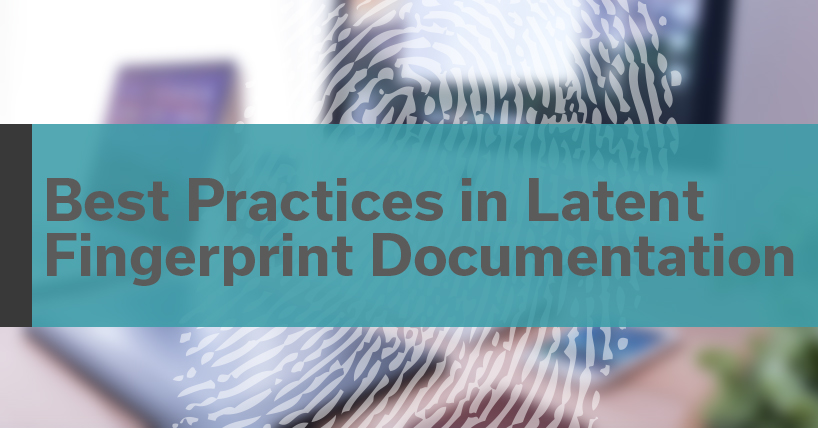Under-Documenting and Over-Documenting Equally Likely to Put Your Agency at Risk

When it comes to latent fingerprint documentation, you may think that more is always better. But experience has shown that is not the case. A court case can be jeopardized by too little or too much documentation. Your agency needs a process that meets the needs of the customers you serve.
“There has to be a purposeful discussion about documentation where the result, the end customer of the worksheets and reports, the effect on the workflow, and the purpose for all documentation are all considered,” notes Steve Scarborough, a subject matter expert and trainer for Mideo who has worked on the documentation processes for multiple agencies.
Scarborough worked in local law enforcement as well as the FBI during a career that spanned more than 30 years. He has written articles and given presentations on best practices in print documentation. His observation is that many agencies throughout the country either under document or over document their processes.
The Risks of Under-Documenting and Over-Documenting
Under-documenting typically occurs within agencies that have not changed their approach from when they started their documentation processes. Twenty years ago, not much was documented. Most of the details were recorded in the minds of the experts.
“When they went into court, they would relay what they did from memory,” Scarborough says. “Sometimes there were handwritten notes as well, but not much.”
Today there is a general understanding that documentation is important. Agencies are at many different levels of addressing this need and there is a wide range of approaches to documentation.
Over-documentation happens as well. Scarborough finds this can be a common outcome when agencies overcompensate due to media reports of anticipated or actual attacks on evidence by defense attorneys and by critics of forensics science. The danger is in getting bogged down and making the entire documentation process ineffective.
“If you are having difficulty keeping up with the backlog, you need to look at documentation to determine if it is slowing down the process,” Scarborough advises.
Not every question is solved with documentation. A qualified examiner should be able to anticipate the core questions about evidence that will satisfy defense questioning.
“A number of years ago at my agency we would take a picture of the packaging to prove and reinforce the statement made in the notes by the examiner. Then they temporally took a picture of the person taking the picture to show the inefficiency and frankly the ridiculousness of going too far in documentation,” Scarborough recalls.
Your Documentation Goal: Complete, Inclusive, and Efficient
The best documentation system for your agency will be complete and inclusive without bogging down the system. The right mindset is to have a documentation process that answers these questions:
- Who is our end customer and what do they need?
- What workflow allows us to provide the needed documentation?
- What is the purpose of each item we document?
Scarborough suggests that SOPs be used to handle unusual situations or needs. The standard process should be as simple as possible to meet typical requirements.
Requirements of documentation should be dictated by the needs of the local agency. Standards required by accreditation should be adapted based on local, not necessarily national, requirements and SOPs.
Find Your Best Practice
Best practices for latent fingerprint documentation should include the information necessary to present a legal case without retarding the workflow process. Requirements most often come from prosecutor’s office. Agencies should also look to the recommendations of governing forensic organizations for guidance.
Documentation is a cornerstone in the effort to assemble a case. The goal is to provide all the necessary information for the expert to be able to recreate the examination and relay that process in the courtroom.
Your process most cover these categories:
- General evidence documentation
- Basic analysis documentation
- Detailed comparison documentation
Moving from a paper-based to an electronic documentation system like LatentWorks can streamline the process. Scarborough has helped agencies take this step, and finds that some things aren’t needed and some can be addressed in a different way.
“An agency may try to get in all information that was initially packed on paper worksheets. Most find that they don’t really need all that information. They just had the room on those worksheets so it was included or put it on for the ‘what if’ situations that really never happen or happen very rarely,” Scarborough says.
Moving to an electronic documentation process can be a time to make the work as efficient as possible, while still building documentation that provides for a complete case. While it may seem like a lot of effort is spent on the front end of the process, software like LatentWorks ensures that all elements of solid documentation are present and instantly available prior to court or case review.
LatentWorks provides a software platform designed to bring a systematic workflow-based approach to the documentation of the latent examination process. LatentWorks also assures that there is consistency in terminology across all documentation prepared by all the individuals within each forensic unit.
Learn more about LatentWorks here.
Have a story to share?
We are collecting stories for an upcoming blog post about the pitfalls of poor documentation in court. Do you have any anecdotes you can share, either that happened to you or someone you know? The stories will be anonymous, unless you are comfortable naming names. Just send an email to [email protected].